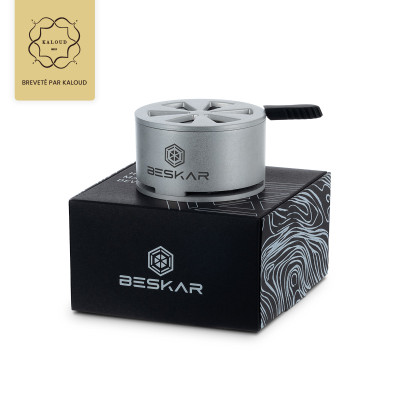The Dangers of Shisha Consumption for Health
Shisha, also known as nargila or hookah, is a tobacco smoking practice that dates back centuries in many cultures around the world. A mysterious object that both fascinates and intrigues, shisha, although familiar to millions of people worldwide, remains relatively unknown. Countless newspaper articles hastily written paint an apocalyptic picture of shisha, claiming that smoking it is equivalent to 20, 50, or even 100 cigarettes, depending on the claims. But what is the reality? What are the real dangers of shisha consumption for your health? That's the complex subject we'll attempt to address here.
1. Inhalation of Harmful Substances
One of the primary dangers of shisha consumption is the inhalation of harmful substances. The combustion of the charcoal used to heat the tobacco, as well as the combustion of the tobacco itself, leads to the formation of harmful substances for the body, such as carbon monoxide and nicotine. Prolonged exposure to harmful substances increases the risk of serious health problems.
2. Increased Risk of Respiratory Diseases
Shisha consumption is likely to increase the risk of respiratory diseases. Fine particles present in shisha smoke can irritate the airways, potentially leading to issues such as bronchitis, emphysema, and long-term lung cancer. Shisha smokers are also more likely to develop respiratory infections, especially when sharing the same mouthpiece.
3. Nicotine Addiction
Nicotine is a highly addictive substance present in shisha, just like in cigarettes. Shisha smokers can quickly develop a dependence on nicotine, making it difficult to quit this habit. Nicotine addiction is not only harmful to health but can also have significant long-term financial implications.
4. Risk of Cardiovascular Diseases
Shisha consumption is also associated with an increased risk of cardiovascular diseases. The nicotine in shisha can raise blood pressure and heart rate, potentially leading to issues such as hypertension, heart attacks, and strokes. Individuals with a family history of heart disease should be particularly cautious about shisha consumption.
5. Scientifically Understudied Topic
While the risks associated with shisha smoking are indisputable, scientific literature specifically dedicated to the practice of hookah remains relatively scarce in medical research. While the risks of conventional shisha consumption are known, mainly through analogies with cigarettes, there have been no more than a dozen specific studies on shisha use worldwide. As a result, shisha is often demonized "a priori" without rigorous research or precise measurements.
6. Limited and Unrepresentative Studies
The few studies that have focused on shisha are relatively old compared to the rapid development of equipment used by shisha smokers in recent years. They have been conducted by scientists who are unfamiliar with the object and its actual use, resulting in protocols that are not representative of actual shisha use. Moreover, these studies have only focused on the use of tobacco in shisha. However, a shisha can be used to consume various products, such as steam stones, cellulose-based tabamel, gels, glycerin pastes, creams, and, of course, tobacco. Therefore, there is a lack of rigorous research into the different ways of consuming shisha and their relative safety or increased danger. At this stage, the only scientific position is to assert that "we don't really know what the different ways of consuming hookah are."
7. Studies Distorted for Buzz
Journalists who have chosen to cover the topic of shisha have greatly contributed to spreading false ideas about shisha consumption, particularly by highlighting sensational data that is easy to remember and conducive to generating buzz. Many newspaper articles have, for example, reported with horror that a one-hour shisha session is equivalent to inhaling the smoke volume of 20, 50, or even 100 cigarettes. These claims were naturally supported by smoky references "according to a study by..." meant to convince the public. It's important to understand the basis of such a claim. The studies referred to by journalists indicate that smoking shisha for an hour equates to inhaling a smoke volume equivalent to that of smoking 20 or 50 cigarettes. However, given the different nature of the smoke, no reasonable conclusion can be drawn from this data, and it essentially amounts to saying that shisha produces more smoke than cigarettes, something anyone can observe without resorting to extensive scientific analysis. To date, there is no precise comparative study between shisha and cigarettes.
8. Multiple Ways to Reduce Risks
While it is reasonable to assume that smoking shisha with charcoal and tobacco can be harmful, there are numerous possibilities today to reduce the risks associated with shisha use. Although these innovations cannot make shisha use completely risk-free, they can significantly reduce the risks and provide interesting prevention tools without sacrificing the social aspect of shisha. Alternatives to tobacco for shisha, such as WAYS flavors, have emerged. These new-generation flavors do not contain nicotine, allowing shisha to be consumed without the risk of addiction. Reasonable and responsible consumption is possible with such flavors, offering the same tastes and clouds but without the addictive nature of nicotine. The use of natural charcoal (without chemical accelerants) is also a way to inhale fewer pollutants. While natural charcoal still emits carbon monoxide, the amount of CO released by natural charcoal remains low and is unlikely to intoxicate the user, as a malfunctioning heating device might, for example. The use of a heat transfer system, instead of aluminum, also helps to heat the tobacco rather than burn it and minimizes the amount of volatile substances transported in the smoke.
9. Numerous Benefits of Shisha Consumption
As previously mentioned, scientific research on the toxicity of shisha is unfortunately too fragmented, and there are too few studies on its benefits, which can also be intuitively surmised. Smoking shisha is a social activity, shared by several people, sometimes across generations. This practice helps break the isolation that characterizes modern societies. It is a ritual, a habit that structures days, serves as a reference, and provides an opportunity for dialogue. It would be wrong to underestimate the beneficial aspect of a practice for socialization and the well-being of those who consume it. Isolation and depression are also concerning phenomena that generate dramatic pathologies, which practices that bring individuals together, such as sharing a shisha, help combat.
10. The Electronic Shisha: Shisha Without Charcoal
One of the main problems with shisha consumption is the combustion of charcoal, which generates pollutants inhaled by the user. Technology is also coming to the aid of shisha consumers with the emergence of increasingly advanced electronic shisha models. Similar to electronic cigarettes, which are a powerful tool for preventing smoking-related risks, electronic shisha is now being developed with products like Xbar's X-chicha, allowing users to enjoy sharing (this device even allows the simultaneous use of two hoses) without using any charcoal or combustion. Without nicotine, the flavors of Xbar's X-chicha do not create addiction and can be consumed without guilt.
11. Conclusion
Shisha consumption is not without health risks. It is essential to be aware of these risks and consider healthier alternatives to preserve long-term health. However, the alarmist articles published in many newspapers are superficial and do not grasp the complexity of shisha consumption, lacking scientific foundations. Technological advancements make it possible to consume shisha with reduced risks compared to the traditional hookah. The shisha and vape industries are working together to develop new products that retain the socialization benefits associated with hookah use while reducing risks.









